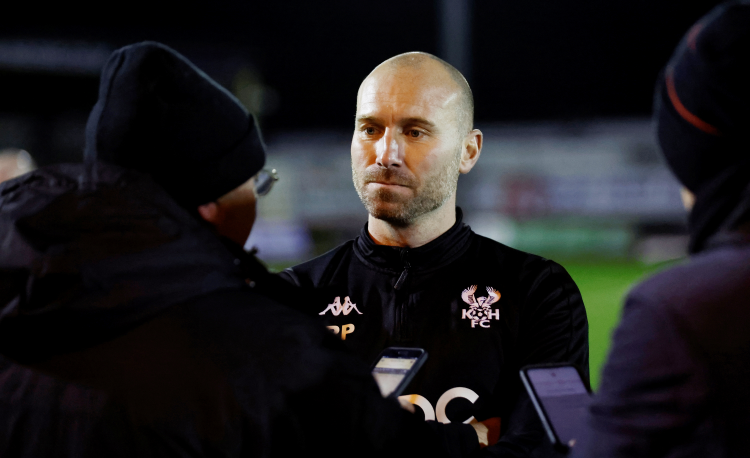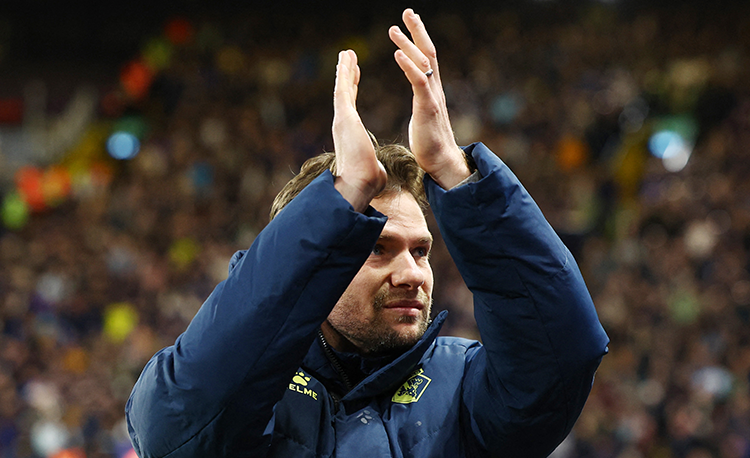You are viewing 1 of your 1 free articles
Attacking overloads on transition (counter attacks)
This session is based on a defensive mid-block structure, transitioning into a quick regain and attack against a team out of position.
| Area | Full size pitch |
| Equipment | Balls, bibs, cones, flat discs, 2 full size goals, 4 corner flags |
| No. of Players | 20 players + 2 goalkeepers |
| Session Time |
Rondo transition: 15mins |
This session is based on a defensive mid-block structure, transitioning into a quick regain and attack against a team out of position. It is about thinking about how we turn an organised out-of-possession shape into a potential goalscoring opportunity.
We start with a rondo transition, before moving into an attacking overloads session which progresses, then doing an 11v11 match prep practice.
We look to run this session on matchday -2.
“The session is about considering how we turn an organised out-of-possession shape into a potential goalscoring opportunity”
Rondo transition
We set up in an area, 12x12 yards, split into 4 squares, with a 2x2-yard mini central area in the middle. We split the 20 outfield players into four teams of five. Two servers are positioned as shown. Goalkeepers are working separately elsewhere.
One team in an outside area starts with the ball, looking to keep it, rondo style, against one player from the defensive team, which starts in the middle area. The team in possession must have a different team at each side of their area. The possession team must make eight passes in their area before they can pass to the team either side of the area [1a].
[1a]
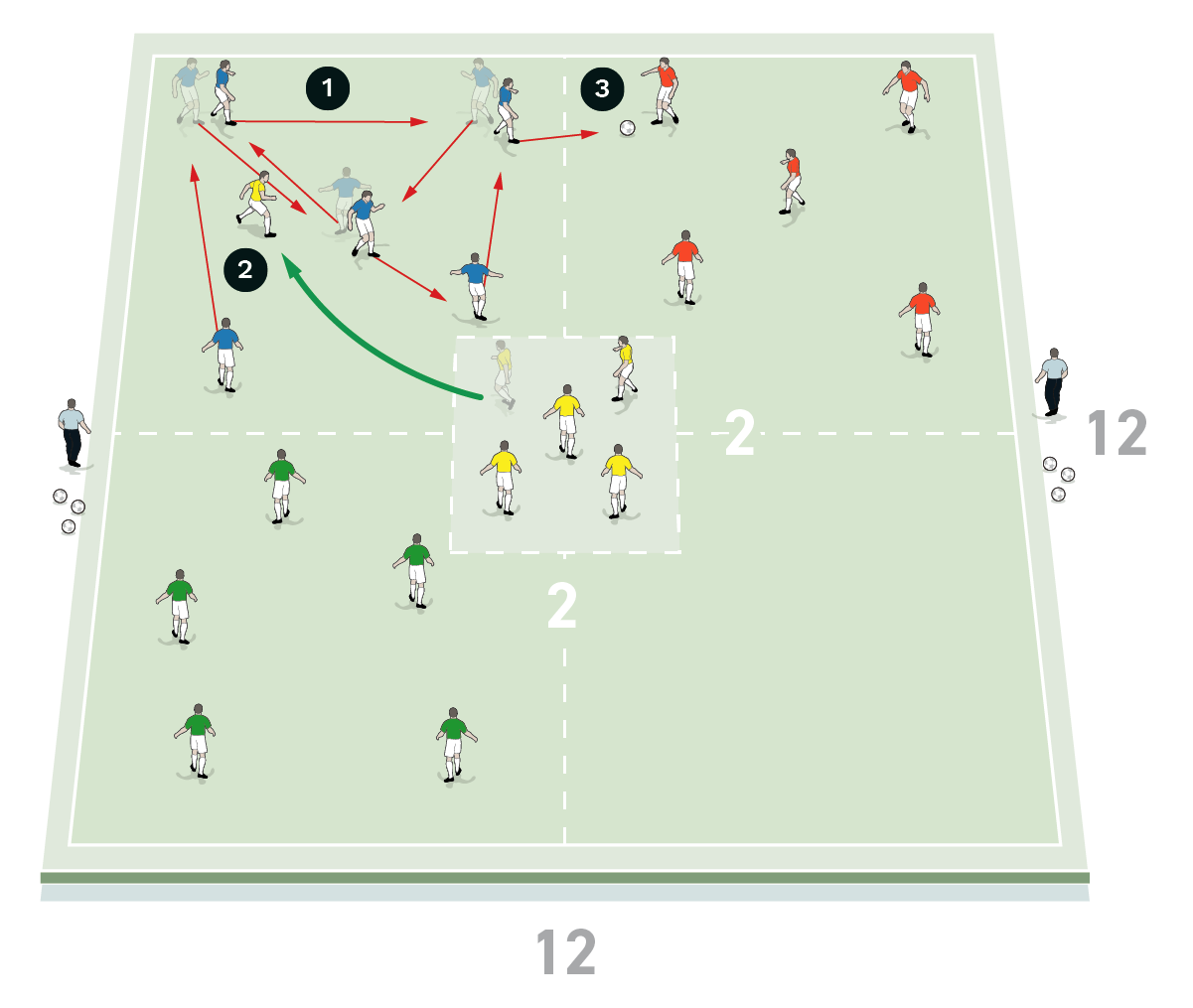
-
The blues start with the ball
- One yellow defender enters the square
- The blues complete eight passes before playing the ball to the red team in their square
The in-possession team now looks to make eight passes, against a new defender from the middle area. The teams around them adjust position as needed so the in possession team has a team to either side of their area [1b].
[1b]

-
The yellow defender returns to their square
- A new yellow defender enters the reds’ square to try and win the ball
- The greens move into the empty square so the team in possession has another team in each adjacent area
Short movements and one and two-touch passing should be prevalent, while the detail of the pass into the other area is key as it sets the tone for their 5v1.
The team moving to support should complete short and sharp five-yard bursts.
We would look to do this in two sets of four 90-second blocks, with every team given the opportunity to defend. The competitive element will be in how many transfers can be achieved in the 90 seconds.
Attacking Overloads (Part 1)
We now use half a pitch to get some flow to the session, coned off from the corner quadrants to the edge of the centre circle, as shown. Corner flags are also in place. We use one full size goal with a goalkeeper, and have 10v10 outfield - blues v reds - set up as shown. A coach will serve the balls from near the centre circle.
The reds start with the ball in the centre circle to form a 5v1 rondo, with the one blue defender aiming to win the ball back. The reds must complete four passes between them before playing the ball to the break-out forward in an area around 30 yards from goal. Two reds from the rondo join to form a 3v1 counter-attack with the aim of scoring [2].
[2]

-
The reds complete four passes in the rondo around the blue defender
- A red player plays the ball forward to the break-out forward
- Two reds from the rondo join the attack to form a 3v1
I’m looking for plenty of one and two-touch passing in the rondo, with good ball speed and movement off the ball. Weight and speed of pass from the rondo to the break-out forward is important, as is playing it on the safeside. I’m looking for players to use underlaps, overlaps, or pass and follow.
Attacking Overloads (Part 2)
We revert to a full pitch, coned off from the corner quadrants to the edge of the centre circle, as shown. We play a full 11v11. Corner flags are used.
The reds start with the ball in the centre circle, forming a 5v1 rondo against a blue defender looking to win the ball. The reds must complete four passes before playing the ball forward to the break-out forward in a central position, 30 yards from goal. Three reds then join the attack to create a 4v2 breakout attacking situation [3].
[3]
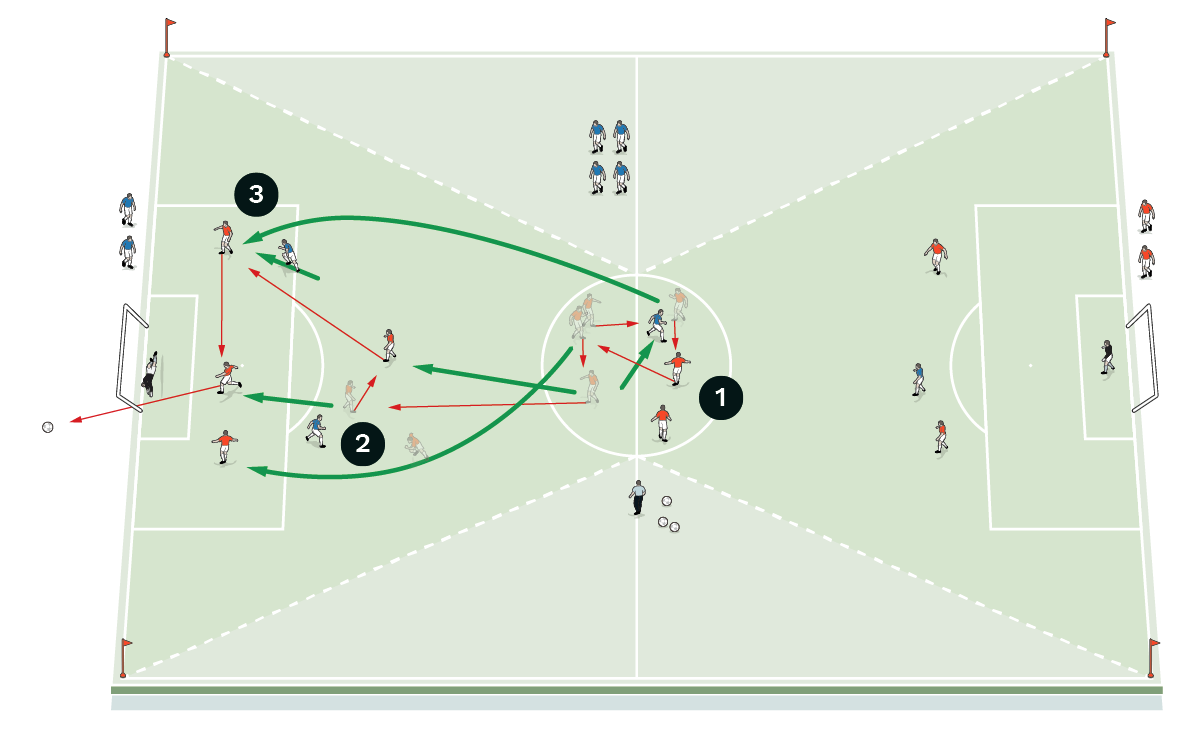
-
The reds complete four passes in the rondo around the blue defender
- A red player plays the ball forward to the break-out forward
- Three reds from the rondo join the attack to form a 4v2
“I’ll be looking at how the move is finished. So I’m looking at the connection, the detail of the finish, the forward’s body position, as well as the weight of the ball played to the forward to connect”
I’ll be looking more at how the move is finished in this instance. So I’m looking at the connection, the detail of the finish, the forward’s body position, as well as the weight of the ball played to the forward to connect.
11v11 (Match Preparation)
We use a full pitch with two full size goals with a goalkeeper at each end. A 40x30-yard box will also be marked out in the middle of the pitch, an area used as a reference to where we have an overload.
We play 11v11. In terms of match preparation, we think about how we adapt in terms of the shape and personnel the opposition are likely to line up in. In this example, the reds set up in a 4-2-3-1 formation, the blues in a possession-based 4-3-3. We play three six-minute blocks initially. It is a normal matchday rules scenario.
We’re looking to regain possession [4a] and create a goalscoring opportunity [4b].
[4a]

-
The blue player loses possession to the red - who plays the ball back
- The red player plays the ball into the red forward
[4b]
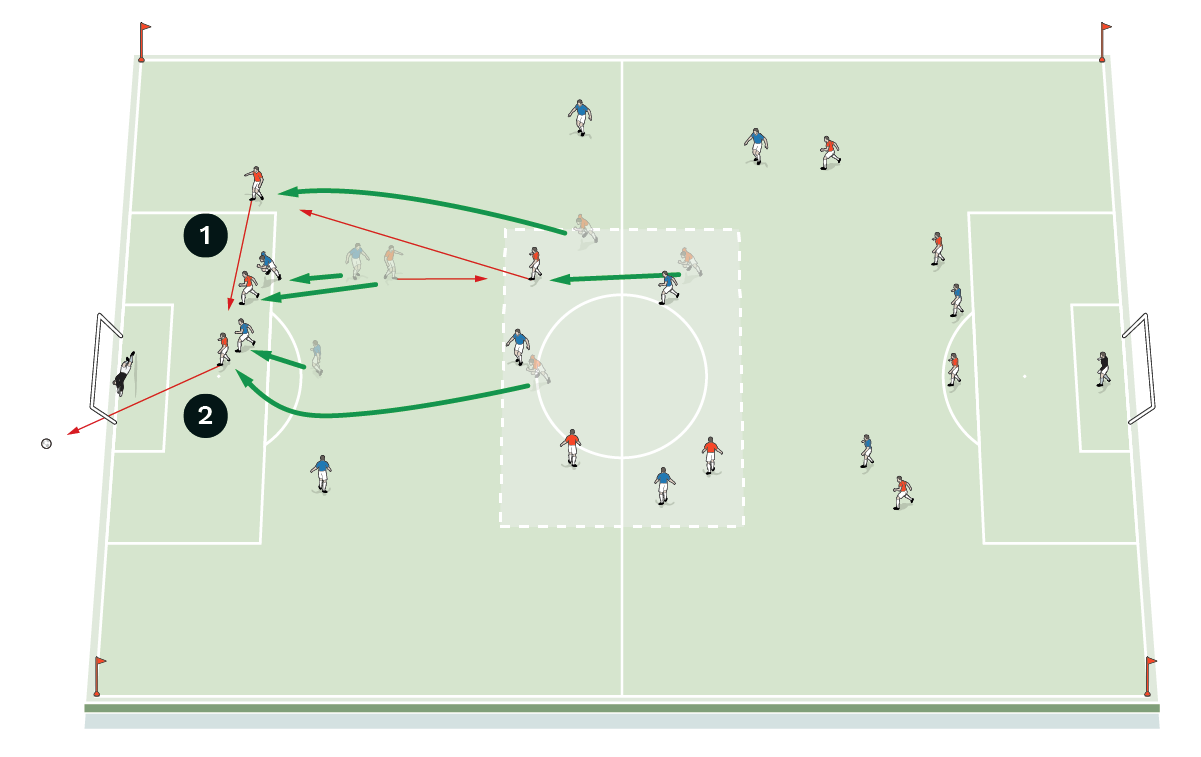
-
The reds isolate two blue defenders to create a 4v2 situation
- The reds use the extra players to create a goalscoring chance
The stipulation on regaining possession is - can we get that first pass in? Followed by making a forward pass into the front man as quickly as possible, with pace - and then support. This element of the session touches on all we’ve worked on in the practices prior.
“The stipulation on regaining possession is - can we get that first pass in? Followed by making a forward pass into the front man as quickly as possible, with pace - and then support”
COACHING POINTS
Why do you use corner flags in the exercise?
Pitch geography. The players can use them as references.
Why do you funnel the pitch off?
It allows for match preparation detail on upcoming opposition, particularly if the opposition play high full-backs and like to play through centrally. So my session is designed around us regaining possession mid-area, followed by attack through the middle using our overload.
Editor's Picks
Deep runs in the final third
Using the goalkeeper in build-up play
Pressing principles
Intensive boxes drill with goals
Penetrating the final third
Creating and finishing
My philosophy
Pressing initiation
Compact team movement
Coaches' Testimonials

Alan Pardew

Arsène Wenger

Brendan Rodgers

Carlos Carvalhal

José Mourinho

Jürgen Klopp

Pep Guardiola

Roy Hodgson

Sir Alex Ferguson

Steven Gerrard
Coaches' Testimonials

Gerald Kearney, Downtown Las Vegas Soccer Club

Paul Butler, Florida, USA

Rick Shields, Springboro, USA

Tony Green, Pierrefonds Titans, Quebec, Canada
Join the world's leading coaches and managers and discover for yourself one of the best kept secrets in coaching. No other training tool on the planet is written or read by the calibre of names you’ll find in Elite Soccer.
In a recent survey 92% of subscribers said Elite Soccer makes them more confident, 89% said it makes them a more effective coach and 91% said it makes them more inspired.
Get Monthly Inspiration
All the latest techniques and approaches
Since 2010 Elite Soccer has given subscribers exclusive insight into the training ground practices of the world’s best coaches. Published in partnership with the League Managers Association we have unparalleled access to the leading lights in the English leagues, as well as a host of international managers.
Elite Soccer exclusively features sessions written by the coaches themselves. There are no observed sessions and no sessions “in the style of”, just first-hand advice delivered direct to you from the coach.
